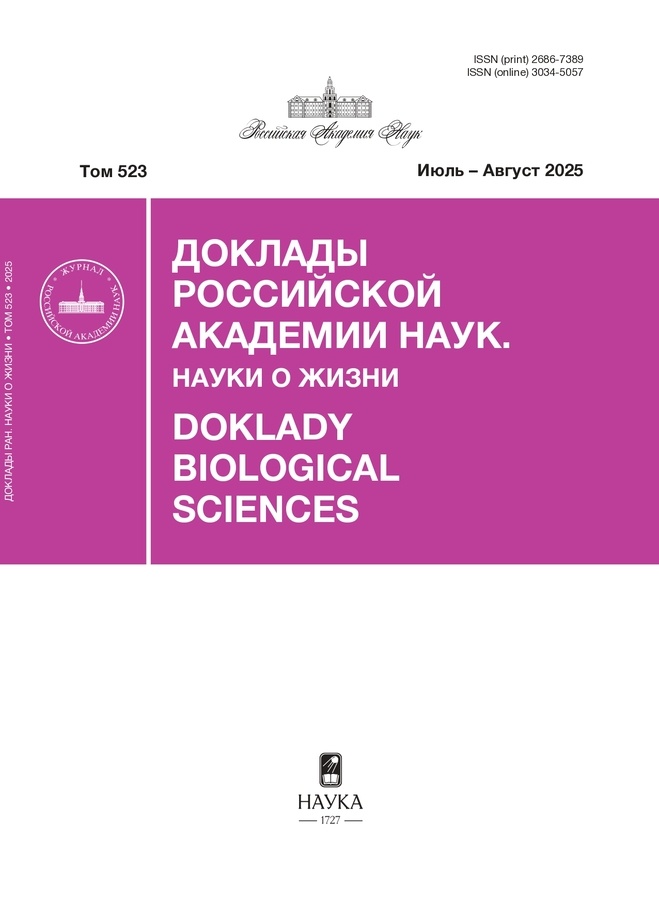Plecotus macrobullaris sarmaticus subsp. nov. (Vespertilionidae, Chiroptera) из раннего плейстоцена Крыма
- Авторы: Лопатин А.В.1
-
Учреждения:
- Палеонтологический институт им. А.А. Борисяка Российской академии наук
- Выпуск: Том 516, № 1 (2024)
- Страницы: 26-33
- Раздел: Статьи
- URL: https://gynecology.orscience.ru/2686-7389/article/view/651426
- DOI: https://doi.org/10.31857/S2686738924030053
- EDN: https://elibrary.ru/VUBHIM
- ID: 651426
Цитировать
Полный текст
Аннотация
По челюстным остаткам из нижнего плейстоцена пещеры Таврида в центральном Крыму описан вымерший горный ушан Plecotus macrobullaris sarmaticus subsp. nov. Это первая находка рода Plecotus в нижнем плейстоцене России и первая ископаемая находка P. macrobullaris Kuzyakin, 1965, документирующая раннюю стадию эволюционной истории вида.
Ключевые слова
Полный текст
Об авторах
А. В. Лопатин
Палеонтологический институт им. А.А. Борисяка Российской академии наук
Автор, ответственный за переписку.
Email: alopat@paleo.ru
Россия, Москва
Список литературы
- Spitzenberger F., Strelkov P.P., Winkler H., Haring E. A Preliminary Revision of the Genus Plecotus (Chiroptera, Vespertilionidae) Based on Genetic and Morphological Results // Zoologica Scripta. 2006. V. 35. № 3. P. 187–230.
- Handbook of the Mammals of Europe. Chiroptera / Ed. Russo D. Cham, Switzerland: Springer, 2023. 980 p.
- Rosina V.V., Rummel M. The Bats (Chiroptera, Mammalia) from the Early Miocene of Petersbuch (Bavaria, Southern Germany) // Geobios. 2012. V. 45. № 5. P. 463–478.
- Wołoszyn B.W. Pliocene and Pleistocene Bats of Poland // Acta Palaeontologica Polonica. 1987. V. 32. № 3–4. P. 207–325.
- Topál G. Tertiary and Early Quaternary Remains of Corynorhinus and Plecotus from Hungary (Mammalia, Chiroptera) // Vertebrata Hungarica. 1989. V. 23. P. 33–55.
- Rabeder G. Plecotus und Barbastella (Chiroptera) im Pleistozän von Österreich // Naturkundliches Jahrbuch der Stadt Linz. 1974 (1973). V. 19. P. 159–184.
- Rosina V.V., Kruskop S.V., Semenov Y.A. New Late Miocene Plecotine Bats (Chiroptera, Vespertilionidae: Plecotini) from Gritsev, Ukraine // Palaeovertebrata. 2019. V. 42. № 1. P. 1–13. https://doi.org/10.18563/pv.42.1.e2
- Horáček I., Bogdanowicz W., Ðulić B. Plecotus austriacus (Fischer, 1829) – Graues Langohr // Handbuch der Säugetiere Europas. V. 4 (II): Fledertiere (Chiroptera) II / Eds. Niethammer J., Krapp F. Wiebelsheim: Aula-Verlag, 2004. P. 1001–1049.
- Galán J., Núñez-Lahuerta C., Moya-Costa R., et al. Fossil Bat Assemblages as Palaeoenvironmental and Palaeoclimatic Indicators: A Case Study in the Lower to Middle Pleistocene Gran Dolina Sequence of Sierra de Atapuerca, Northern Spain // Palaeogeography, Palaeoclimatology, Palaeoecology. 2019. V. 535. Art. 109365. https://doi.org/10.1016/j.palaeo.2019.109365
- Juste J., Ibáñez C., Muñoz J., et al. Mitochondrial Phylogeo- graphy of the Long-eared Bats (Plecotus) in the Mediterranean Palaearctic and Atlantic Islands // Molecular Phylogenetics and Evolution. 2004. V. 31. № 3. P. 1114–1126.
- Alberdi A., Gilbert M.T.P., Razgour O., et al. Contrasting Population-level Responses to Pleistocene Climatic Oscillations in an Alpine Bat Revealed by Complete Mitochondrial Genomes and Evolutionary History Inference // Journal of Biogeography. 2015. V. 42. № 9. P. 1689–1700.
- Лопатин А.В. Раннеплейстоценовый подковонос Rhino- lophus macrorhinus cimmerius subsp. nov. (Rhinolophidae, Chiroptera) из пещеры Таврида в Крым // Доклады Российской академии наук. Науки о жизни. 2022. Т. 506. С. 396–405.
- Лопатин А.В. Раннеплейстоценовый кожан Eptesicus praeglacialis (Vespertilionidae, Chiroptera) из пещеры Таврида в Крыму // Доклады Российской академии наук. Науки о жизни. 2023. Т. 508. С. 95–104.
- Лопатин А.В. Rhinolophus mehelyi scythotauricus subsp. nov. (Rhinolophidae, Chiroptera) из нижнего плейстоцена пещеры Таврида в Крыму // Доклады Российской академии наук. Науки о жизни. 2023. Т. 509. С. 109–114.
- Лопатин А.В. Eptesicus nilssonii varangus subsp. nov. (Vespertilionidae, Chiroptera) из нижнего плейстоцена пещеры Таврида в Крыму // Доклады Российской академии наук. Науки о жизни. 2023. Т. 510. С. 308–315.
- Лопатин А.В., Вислобокова И.А., Лавров А.В. и др. Пещера Таврида – новое местонахождение раннеплейстоценовых позвоночных в Крыму // Доклады Академии наук. 2019. Т. 485. № 3. С. 381–385.
- Ruprecht A. Metody wyróżniania Plecotus austriacus Fischer, 1829 i nowe stanowiska tego gatunku w Polsce // Acta Theriologica. 1965. V. 10. № 14. P. 215–220.
- Ruprecht A.L. Taxonomic Value of Mandible Measurements in the Genus Plecotus Geoffroy, 1818 // Acta Theriologica. 1969. V. 14. № 6. P. 63–68.
- Spitzenberger F., Haring E., Tvrtković N. Plecotus microdontus (Mammalia, Verspertilionidae), a New Bat Species from Austria // Natura Croatica. 2002. V. 11. № 1. P. 1–18.
- Galán J., Núñez-Lahuerta C., Bartolomé M. The Tale of an Ice-preserved Alpine Long-eared Bat in the Pyrenees // Journal of Bat Research and Conservation. 2022. V. 15. № 1. P. 69–71.
Дополнительные файлы
Доп. файлы
Действие
1.
JATS XML
2.
Рис. 1. Plecotus macrobullaris sarmaticus Lopatin subsp. nov., экз. ПИН, № 5644/651, фрагмент правой верхнечелюстной кости с M1 (СЭМ): а – с лабиальной стороны, б – с окклюзиальной стороны; Россия, Крым, пещера Таврида; нижний плейстоцен.
Скачать (127KB)
3.
Рис. 2. Plecotus macrobullaris sarmaticus, Lopatin, subsp. nov. (СЭМ): а–в – голотип ПИН, № 5644/652, левая нижнечелюстная кость с P4–M3 : а – с лабиальной стороны, б – с окклюзиальной стороны, в – с лингвальной стороны; г–е – экз. ПИН, № 5644/653, левая нижнечелюстная кость с M3: г – с лабиальной стороны, д – с окклюзиальной стороны, е – с лингвальной стороны; ж–и – экз. ПИН, № 5644/654, левая нижнечелюстная кость без зубов: ж – с лабиальной стороны, з – с окклюзиальной стороны, и – с лингвальной стороны; Россия, Крым, пещера Таврида; нижний плейстоцен.
Скачать (288KB)
4.
Рис. 3. Plecotus macrobullaris sarmaticus, Lopatin, subsp. nov.: а–г – голотип ПИН, № 5644/652, левая нижнечелюстная кость с P4–M3: а – восходящая ветвь с лабиальной стороны, б – восходящая ветвь с лингвальной стороны, в – M3 с задней стороны, г – горизонтальная ветвь с P4–M3 с окклюзиальной стороны; д–ж – экз. ПИН, № 5644/653, левая нижнечелюстная кость с M3: д – восходящая ветвь с лабиальной стороны, е – восходящая ветвь с лингвальной стороны, ж – M3 с задней стороны (а, б, г–е – СЭМ; в, ж – компьютерные модели); Россия, Крым, пещера Таврида; нижний плейстоцен.
Скачать (247KB)











